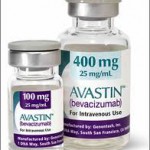If you like this blog, send it to 3 (or more) of your friends and encourage them to sign up. Let’s keep the conversation going!
In a previous blog post, I tried to explain the importance of understanding what was being measured in clinical trials for cancer drugs, and why it mattered. If you want to refresh your memory on this, it’s entitled “People’s Lives as the Endpoints of Medical Research – Now There’s An Nifty Idea.”
 The example I used in that blog post was Avastin (generic name bevacizumab). This drug has been the subject of many hearings at the FDA — the most recent in late June, 2011 — and more news stories than can be counted of outcry from breast cancer patients. Behind all this noise, we seem to have lost sight of the purpose of putting cancer drugs on a “fast track” to FDA approval. If that purpose is lost, the end result will be a lot of drugs on the market that don’t work, and a lot of very sick people for whom hope will have been met with an empty promise and, possibly, a lot of side effects that will make their last days more miserable than they need to be.
The example I used in that blog post was Avastin (generic name bevacizumab). This drug has been the subject of many hearings at the FDA — the most recent in late June, 2011 — and more news stories than can be counted of outcry from breast cancer patients. Behind all this noise, we seem to have lost sight of the purpose of putting cancer drugs on a “fast track” to FDA approval. If that purpose is lost, the end result will be a lot of drugs on the market that don’t work, and a lot of very sick people for whom hope will have been met with an empty promise and, possibly, a lot of side effects that will make their last days more miserable than they need to be.
Fast Track Approval for Cancer Drugs: The Idea
In 1992, almost twenty years ago, Congress passed PDUFA (The Prescription Drug User Fee Act). Among other things, that law provides that drug companies pay fees to the FDA to increase the agency’s drug review capacity. With that increased capacity in hand, a law called the Food and Drug Administration Modernization Act of 1997 established a process for rapid approval of treatments for life-threatening conditions and unmet medical needs. The purpose of this approach, as the FDA puts it, “is to get important new drugs to the patient earlier.”
Addressing an “unmet medical need” is defined by the FDA as “providing a therapy where none exists or providing a therapy which may be potentially superior to existing therapy.” According to the agency, if there are existing therapies, a drug for which fast track approval is sought must show some advantage over available treatment, such as superior effectiveness or avoiding serious side effects that occur with an already-available treatment.
When a drug is considered for fast track approval, the FDA allows surrogate endpoints to be used to demonstrate the drug’s effectiveness. As defined by the FDA, “effectiveness” in this context means that the end point used represents a clinically meaningful outcome, such as longer survival or mitigated symptoms. By relying on these surrogate endpoints, drug companies can reduce the amount of time needed to get through the FDA approval process and get their drugs to market.
But there is a kicker, which is where Avastin got into trouble. Fast track, or accelerated, approval of a drug based on surrogate endpoints is given on the condition that post- marketing clinical trials (done after the drug is approved) verify the clinical benefit anticipated with the surrogate endpoints. In other words, the studies done after the drug is given fast-track approval for marketing must show that the benefit for which a surrogate was measured actually occurred in patients.
So, fast-track FDA approval is always conditional: conditioned on a showing by the manufacturing company that the drug actually improves patient outcomes in meaningful ways. The company is required to show that the surrogate endpoint that merited early approval for its drug is borne out by measurable and positive clinical outcomes for patients in later trials. Getting fast-track approval is not a guarantee that a drug will get full approval from the FDA. It is meant to be a guarantee that drugs that actually help patients will get to those who need them sooner.
Does the Drug Meet Its Promise?: Where The Rubber Meets the Road
So fast track approval for a drug is not the final step in the drug approval process.
In the single trial that led to the accelerated approval of Avastin for breast cancer, the surrogate endpoint was time to progression: a delay in median time before tumors started to grow in patients on the drug. There was no evidence at that time that the drug improved patient outcomes. It was believed that further trials would show this benefit, either by lengthening patients’ lives, or improving the quality of their lives by improving how they felt while on the drug as compared to other treatments.
Unfortunately, several subsequent trials performed by the manufacturer, Genentech, showed less benefit in time-to-progression terms than the trial on which approval was based. And none of these trials demonstrated the meaningful clinical outcome for patients on which accelerated approval was premised. Based on these trial results, the FDA’s Oncologic Drug Advisory Committee (ODAC) recommended revoking marketing approval for Avastin for breast cancer in July, 2010.
Genentech Knew the Rules
None of what is described above was unknown to Genentech. The company has been involved in the FDA drug approval process for years, and has had many conversations with the FDA during the drug development process.
Genentech knew that, for full approval of Avastin for breast cancer, it had to show more benefit than it had in the study that led to accelerated approval.
Despite what the company knew, they requested an appeal hearing on the ODAC’s 2010 recommendation. Though other fast-tracked drugs have been removed from the market, never had there been an appeal hearing like this.
In the extraordinary two-day hearing before the ODAC in late June, 2011, Genentech made an interesting and troubling argument in its appeal. Essentially, the company argued that the drug should stay on the market while the company conducts one more trial to try to show the drug’s actual benefit.
This might seem like a reasonable request. But consider this. Avastin went on the breast cancer market in early 2008 on an accelerated basis. Genentech thereafter conducted several trials that were required as a condition of its fast-track approval. Those trials not only did not show the improvement in time-to-progression that the first trial showed, they also showed no clinically meaningful benefit for patients. Removal from the market is a step the company knew was likely. But the breast cancer market for Avastin was huge: estimated to be as large as $1billion annually for Genentech.  It doesn’t take much imagination to see that the magnitude of this potential financial reward prompted the company’s appeal of the ODAC decision, and the argument they made during the appeal hearing to change the rules.
It doesn’t take much imagination to see that the magnitude of this potential financial reward prompted the company’s appeal of the ODAC decision, and the argument they made during the appeal hearing to change the rules.
Bring in the Patients
Of course, when Avastin received accelerated approval, a lot of women with breast cancer got the drug. (In fact, a lot of women got the drug before that, because Avastin was already approved for lung and colorectal cancer, and therefore could be prescribed by doctors “off label” for other conditions, including breast cancer.)
And, predictably, when the FDA held its recent hearing, many women who were still alive and on the drug showed up to make it clear that the wanted the drug to stay on the market.
The appearance of these women at the FDA hearing got a lot of press attention. One of those women, Crystal Hanna, submitted a statement to the FDA and circulated it on the internet, where many people copied and resubmitted it. She wrote, “It’s so depressing to think that a federal agency can make a decision that can potentially cause me to die.”
Represented on the ODAC are medical experts as well as patient and consumer representatives. At the hearing itself, someone who wanted Avastin kept on the market  yelled, “What a patient representative! You better hope your breast cancer doesn’t come back. You’re an embarrassment to all cancer survivors.”
yelled, “What a patient representative! You better hope your breast cancer doesn’t come back. You’re an embarrassment to all cancer survivors.”
Among the women who weren’t at the hearing were those who, despite or even because of Avastin, had died of breast cancer. The dead have no voice. But, fortunately, there was extensive evidence prepared both by FDA staff and Genentech for the ODAC to consider. That evidence provided a broader context for evaluating the passionate statements of those who showed up to argue for the drug.
Unfortunately, none of this evidence was heard by the angry women who showed up to defend Avastin at the hearing, because none of them stayed to hear the ODAC presentations by Genentech and FDA staff or the discussion by the committee. They did, however, return for the vote and the protest they had organized to follow.
While the Controversy Continues
The ODAC voted unanimously at its June hearing to recommend (for the second time) revoking the approval of Avastin for breast cancer. The ultimate decision will be made by the Commissioner of the FDA, Margaret Hamburg.
Whatever that decision is, there will be controversy leading to and following it, and probably further action. Congress may get involved, as it is wont to do when constituents with breast cancer raise their voices. Genentech may bring legal action, or an individual patient might. The Obama administration may not want anything right now to smack of rationing care, which would bring pressure on the Commissioner to leave the drug on the market.
If Avastin stays on the market for breast cancer, the result will be to so undermine the fast track drug approval process as to make that process meaningless. And that is not in the interest of patients, especially the ones who think they need these drugs.
© Barbara A. Brenner 2011
November 18, 2011: Today the FDA Commissioner did the right thing. Avastin is no longer approved for breast cancer treatment. Http://nyti.ms/td1Fql Let’s hear it for following the rules and protecting lives.


The whole Avastin debacle is troubling indeed, however I believe the FDA’s decision to remove the drug from the breast cancer indication is sound, until such time evidence is submitted that would show the contrary. I think the battleground now lies (and perhaps always should have) with Genetech and the insurance companies, in allowing the woman who have made an informed decision to continue with Avastin on an off-label basis, to do so without undue financial penalty. If Genetech is so confident of the breast cancer benefit, then let them continue to study these so-called “super-responders” and either foot the bill or come to an agreement with the insurance companies. Although I wonder how many women are actually caught in this situation given that Medicare will still be covering the breast cancer indication.
Usually, if Medicare covers a drug, private insurers do, also.
Then the question will be how we keep Medicare from becoming bankrupt thanks to very expensive cancer drugs — Avastin is just one example.
I agree that it is best NOT to undermine the fast track process… How many more people would have died of AIDS if the protease inhibitors had not been fast tracked. The responsibility does lie with Genentech to prove the effectiveness of the drug.
I don’t want to hijack this from the breast cancer discussion, but there is another unmet medical need that I hope will soon need to be addressed regarding FDA approval processes.
bbzinger, are you perhaps in the NP-001 ALS clinical trial? It’s all anecdotal so far, but in my 15 years of watching “promising” ALS research, this is the first that I recall patients within a formal clinical trial reporting that they are actually regaining some of those small things that they had lost like blowing out the birthday candles or drinking a cup of coffee.
Many of us are watching and praying that there will soon be data that will make some compelling scientific and ethical issues for the FDA’s consideration when it comes to people with ALS.
God bless. Thanks for sharing your gift with words to make us think.